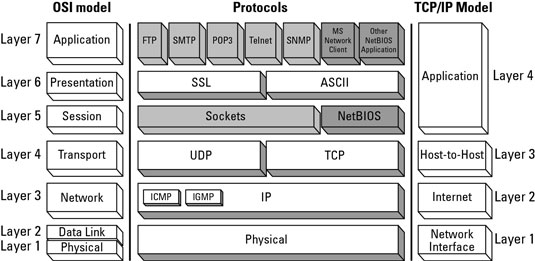Transmission control protocol / Internetworking Protocol (TCP/IP) that define how all transmission are exchanged across the internet. This project is established by Advanced Research Project Agency (ARPA) in 1960. Before it was a known as (ARPANET) Arpa-netwrok. ARPANET developed and called TCP/IP. TCP/IP developed before OSI reference Model. It is also called DOD Model (Department of Defence ).
TCP/IP has four layer:
- Application layer
- Host to host layer / Transport Layer
- Internet layer
- Network Access Layer
 Application Layer
Application Layer
It is the layer that work all similar to three layer of OSI model (application,presentation and session layer).It provides the user interface for communication. The protocol in this layer are FTP, SMTP, POP3 etc.
Transport layer / Host to Host Layer
It defines protocol for setting up the level of transmission services for application. This layer allows the host and destination devices to communicate each other to exchange information.
It ensure following:
- Creating reliable end to end communication.
- Ensuring error-free delivery of data.
- Handle packet sequencing.
- Maintain data integrity.
This layer uses protocol TCP and UDP.
Internet layer
This layer handles how to route the data to its destination and taking care of addressing of hosts by giving IP address.
This layer uses protocol IP, ICMP etc.
Network access layer
It explain how the data is transmitted from the host through the network. It handle the physical addressing of hardware. This layer also responsible to connect different network type to make communication.
This layer uses protocol ATM, Ethernet, Token ring, LAN etc.
TCP/IP vs OSI Reference Model
Differences between them are:
- TCP/IP has four layer while OSI Model has seven layer.
- TCP/IP is realistic but OSI model is ideal.
- TCP/IP uses vertical approach but OSI model uses horizontal approach.
- TCP/IP is developed before OSI model.
- TCP/IP network layer is provide connectionless services while OSI network layer provide both connectionless and connection oriented service.
- TCP/IP transport layer doesn’t guaranties delivery of packets while OSI transport layer does.